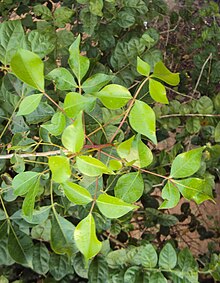Commiphora
| Commiphora | |
|---|---|
 |
|
| Commiphora caudata | |
| Scientific classification | |
| Kingdom: | Plantae |
| (unranked): | Angiosperms |
| (unranked): | Eudicots |
| (unranked): | Rosids |
| Order: | Sapindales |
| Family: | Burseraceae |
| Genus: |
Commiphora Jacq. |
| Species | |
|
ca. 190. See text. |
|
| Synonyms | |
|
|
ca. 190. See text.
The genus of the myrrhs, Commiphora, is the most species-rich genus of flowering plants in the frankincense and myrrh family, Burseraceae. The genus contains approximately 190 species of shrubs and trees, which are distributed throughout the (sub-) tropical regions of Africa, the western Indian Ocean islands, the Arabian Peninsula, India, and Vietnam. The genus is drought-tolerant and common throughout the xerophytic scrub, seasonally dry tropical forests, and woodlands of these regions.
The common name myrrh refers to several species of the genus, from which aromatic resins are derived for various fragrance and medicinal uses by humans.
Leaves in Commiphora are pinnately compound (or very rarely unifoliolate). Many species are armed with spines. Bark is often exfoliating, peeling in thin sheets to reveal colorful, sometimes photosynthetic bark, below. Stems are frequently succulent, especially in species native to drier environments. Flowers are subdioecious and fruits are drupes, usually with a 2-locular ovary (one is abortive). In response to wounding, the stems of many species will exude aromatic resins.
...
Wikipedia
